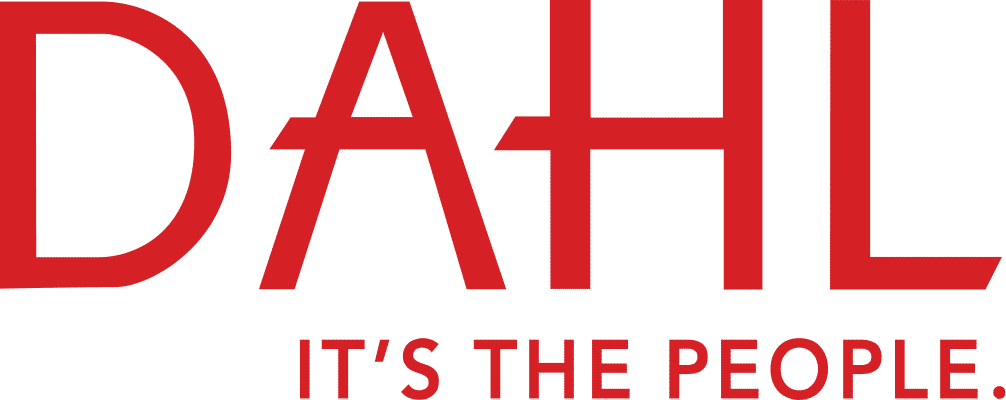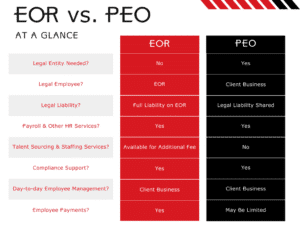Navigating the complex landscape of workforce solutions is crucial for businesses seeking efficient and compliant human resources (HR) management. Dahl Consulting (DAHL), a trusted partner in employment expertise and workforce solutions, understands the importance of making informed decisions when choosing between a Professional Employer Organization (PEO) and an Employer of Record (EOR). In this exploration, we delve into the distinct characteristics of PEO and EOR partnership arrangements, providing valuable insights to help businesses align their employment strategies with their unique staff needs.
PEO
What is a PEO?
A PEO is a Professional Employer Organization defined as a third-party service provider that offers businesses human resources (HR) solutions. These entities act as co-employers, sharing HR responsibilities, including employees and employment liability. PEOs are responsible for various HR functions, including payroll, tax filings, benefits administration, employment practices liability insurance (EPLI), and workers’ compensation insurance.
When should I choose a PEO?
When deciding between a PEO and EOR, it is essential to consider your business plans and trajectory. PEOs are ideal for small to midsize (minimum 5-10 employees) domestic businesses looking to share HR tasks to support a small or non-existent HR staff. When using a PEO, employers can choose what HR responsibilities are offloaded, and it provides a broader spectrum of tasks than an EOR.
It is also important to note that PEOs are considered partners and not separate legal entities. Therefore, it is necessary for companies that want to utilize a PEO to have an existing local legal entity. They share legal responsibilities equally and, therefore, are equally liable for employees.
What are the pros and cons of a PEO?
PEOs offer a variety of pros and cons, and each individual organization should carefully consider if a PEO is the right option for them based on the following information.
Pros
- Access to HR expertise
- Affordable employee benefits
- Minimized administrative burden
- Help with legal compliance and navigation of employment law
- Scalability and flexibility of benefits packages
- Reduced liability
Cons
- Could be more costly in the long run
- Less control or loss of control over certain HR functions
- Limited customization
- Additional costs
- Reliance on a third-party organization
- Potential communication and decision-making challenges
EOR
What is an EOR?
An EOR is an Employer of Record, which means that the company is legally considered the employer for practical applications. EORs are responsible for many of the same HR responsibilities as a PEO, with the addition of state and global regulations, onboarding services, and added compliance protections. One of the main differences between an EOR and a PEO is that working with an EOR allows businesses to hire geographically diverse employees without having a local legal entity in the employees’ respective locales.
When should I choose an EOR?
Because EORs act as the domestic and international legal employer, choosing an EOR is a better option for larger, global companies. This option adds an extra layer of compliance and safety protections for employers, as the employee-employer relationship is no longer the company’s responsibility. EORs are, therefore, fully responsible for paying employees, providing benefits, and issuing bonuses.
EORs may also be a good option for businesses planning to have a local legal entity in the near future, as EORs can be utilized as an interim solution until the legal entity is established.
What are the pros and cons of an EOR?
Like a PEO, EORs also offer advantages and disadvantages for employers. It is important to understand the benefits that an EOR can provide, as well as the potential issues that could occur before deciding on a partnership.
Pros
- Partnership with a trusted advisor for continuous improvement
- Increased cost savings through avoidance of agency markups
- Improved risk mitigation – EORs take full legal responsibility
- Better legal compliance and legal expertise across more geographic areas
- Potential enhanced worker experience through benefit and pay offerings
Cons
- Could be more costly upfront
- Lost control over the workforce
- Cultural mismatches
- Reliance on a third-party organization
- Potential communication and decision-making challenges
Differences Between PEO and EOR at a Glance
In the overall comparison between PEOs and EORs, a PEO primarily provides assistance in handling HR and administrative duties in a broader and shared sense, whereas an EOR takes full responsibility for employees, including HR tasks such as hiring/onboarding and administrative duties, plus all-encompassing legal compliance/protections.
Remembering the key differences between a PEO and an EOR can be difficult, so you may refer to the below graphic to gain an understanding of each option’s unique aspects of each option at a glance.
Whether your organization is opting for the flexibility and reduced liability offered by a PEO or the comprehensive global support and enhanced compliance of an EOR, Dahl Consulting (DAHL) understands that each organization is unique. The nuanced pros and cons of both options demand careful consideration of factors such as cost, control, and long-term business goals.
Dahl Consulting remains committed to guiding organizations through these critical decisions, ensuring that the chosen employment solution aligns seamlessly with their business objectives and paves the way for sustained success in the ever-evolving world of workforce management. If you have further questions regarding PEOs and EORs, get in touch with one of our employment experts at DAHL today!





